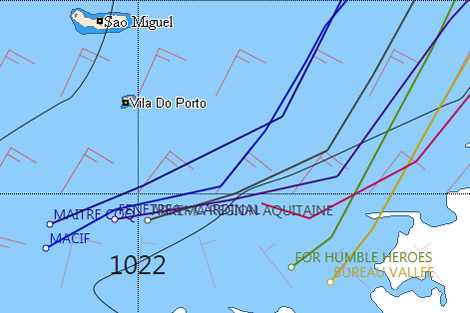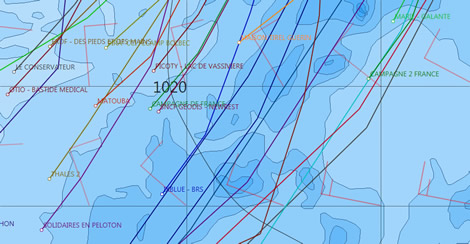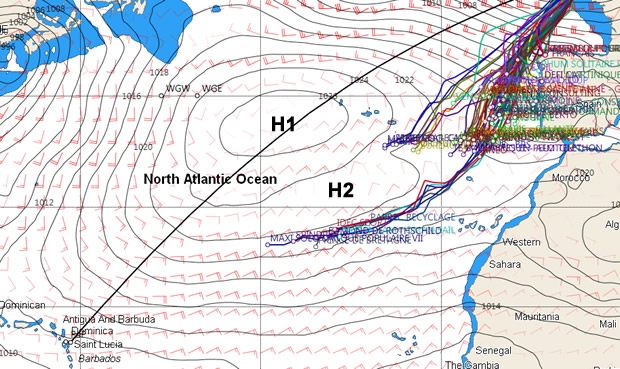60s and Multi50s tiptoe past the Azores
The Ultimes continue to make short shrift of the North Atlantic, the skippers still having to wrestle their enormous craft through gybes as while starboard gybe is marginally favoured it causes them to fall into lighter winds as they encroach too close to the centre of the high to their north. Overnight race leader Loick Peyron on Banque Populaire has put in two gybes as has Yann Guichard on the larger Spindrift 2. However, now comfortably in third place, Lionel Lemonchois on Prince de Bretagne has put in a longer hitch south, which has cost him 40 miles on the race leader in terms of DTF, will hopefully mean he has to gybe less over the course of today.
Over the last 24 hours, Banque Populaire has covered 460 miles and with 1392 miles left to go, if she maintains this speed, her ETA into Pointe a Pitre will be Monday morning. However the wind is forecast to get a little softer on the way to the French Caribbean island on Sunday.
Images courtesy of Expedition and Predictwind

In terms of the fastest boat, then this prize must go to Seb Josse on Edmond de Rothshichild which over the last 24 hours has covered 526 miles, although this is more due to not gybing than raw pace on the water.
The IMOCA 60s passes the east side of the Azores yesterday afternoon. As the map above illustrates they are currently negotiating a relatively narrow band of favourable northeasterlies between the main area of high pressure to their northwest (H1) and a smaller one (H2), which the GFS model has as dissolving by Saturday night. By this time this group will be looking in good shape having sailed a course much shorter than the Ultimes. Saying this the centre of the high is forecast to drop south early next week, so we can expect a general left hand turn to the south into stronger winds after H2 has dissipated.
To stay in this band, and also to cover Jeremie Beyou on Maitre Coq, leader Francois Gabart on MACIF put in a hitch to the north, pulling ahead of Beyou, who at this time had closed to just 8 miles astern of the race leader.

In the Multi 50s in tihs group there has been a leader change with Erwan Le Roux on Fenetrea-Cardinal overhauling Lalou Roucayrol on Arkema Region Aquitaine yesterday afternoon, which seems likely to have been due to some sort of technical problem on the latter boat (unless Lalou just overslept...)
Le Roux this morning just how tricky this section of the race track is: "It's a bit of a mess. We don't really know where the wind is coming from or where the clouds are coming from. We are ahead but that was not expected. You tack or gybe, change sails and then suddenly it picks up. It is tiring as we try to get round the high pressure. But we should soon set gennakers and get downwind.”
Meanwhile the Class40s continue to sail a Route du Rhum course which will end up being similar to the Ultimes, the lead group currently heading directly for Madeira and coming up to the latitude of Gibraltar. Here Thibault Vauchel-camus aboard Solidaires En Peleton has now firmly pulled in front. Technically Kito de Pavant aboard Otio-Bastide Medical is second but as the boats are currently heading way off course, just west of due south, the reality is more that Alex Pella on the Botin Partners-designed Tales 2 Santander is second some 27 miles to the north of the leader, while de Pavant and Yannick Bestaven, sailing the latest Verdier designed Class40 are much further north.

Miranda Merron on Campagne de France is doing an excellent job, theoretically holding ninth, but really in the top six among those heading south. Fingers crossed for Miranda who we hope will put in the best British Route du Rhum Class40 result since Phil Sharp won it in 2006. Behind Conrad Humphries has also risen up the rankings to 14th place but this has been because overnight he's put in a big hitch to the west and is still up at the latitude of Porto.
In the Rhum class, yesterday afternoon while lying 30 miles off La Coruña, Bob Escoffier, the 65 year-old skipper from Saint Malo, was airlifted to safety by the Spanish Navy from his modified Sydney 60 Guisnel Grouo. His boat had been taking in water due to an unknown reason. He was transferred, safe and in good health, to the Spanish base in Vivero.
Escoffier was engaged on his fourth race participation and has also completed three successive Transat Jacques Vabre races between 2001 and 2005. He was a late replacement for his daughter Servane who pulled out of the race in early September for medical reasons.
His helicopter evacuation is the third such rescue after those of François Angoulvant who lost the keel of his Class 40 during the first night of racing and that of Pierre Antoine whose Multi50 was struck by lightning. The drop out rate has always been closely monitored on this four yearly passage from Saint-Malo to Guadeloupe. The usual average rate of skippers abanding is around 30 per cent but has been as high as half the fleet in editions such as in 1986 and 2002. So far there have now been 21 abandons with 70 skippers still racing in the five divisions.
Meanwhile thundering down the Portugese coast this morning is Sir Robin Knox-Johnson, who's Grey Power continues to hold seventh place in the Rhum class. He reports: I am running south about 130 miles off the Portuguese coast, about level with the Douro River. The wind has followed predictions and backed to the South West and is due to increase. Thus the choice was north of west or south at the moment. The tactics have, to a considerable extent, been dictated by when you cleared Ushant. Before me you faced a South Westerly wind so the choice was west, but as I passed the wind veered so I, and some others, was able to make a straight run for Cape Finisterre. I went round the Traffic Separation zone within a mile of Group Berto, a multihull that is lying 6th in class to my 7th. I called him on the VHF but he may have been on deck. Later he was pointing higher than me and veered westward whilst I bore off a bit and skitted round his stern and came south.
There was another boat showing on AIS, but intermittently. I heard voices talking in French but I was on deck at the time.
At this stage there is not much point in pinching this boat as we have a whole ocean before us, it is better to go for speed. Once we get the Trade winds, maybe tomorrow night, I can always harden up if necessary.
Finisterre was unanimously declared a Headland. One has to be a little sparing with Headlands as the whiskey and cigarattes, the normal method of celebration, are not in unlimited supply. In fact, only 3 cigarettes remain aboard, so fairly soon, with an amazing effort of will power, I shall give up smoking!
From a sailing point of view now I have the staysail and main with 3rd reef, averaging 10 plus knots, and comfortable at the moment. The running backstay, which was caught around a batten and would have prevented letting out more sail is now, after a long wrestle, clear. Beneath me the tenor growl of the engine announces a reinforcement of amps into the batteries, the screen is clear of AIS targets, and I have just had a nice cup of tea.
The only problem I have is with the wind instruments, which show a wind speed, and I think reasonably accurately, both True and Apparent, but will not show the direction. This means I cannot ask the auto-pilot to steer by the wind direction, and with constantly changing winds, I have to be around a lot more which reduces my sleep time. I'll get behind the instruments when the boat is not bucking so much and check some of the wirng, but not today, as one jerk and I could lose what I have. There is an equation between being awake more and therefore safer, and having less sleep and so being more dangerous because you are more tired. Modern alarms have done much to favour the getting more sleep option.
RKJ













Latest Comments
Add a comment - Members log in